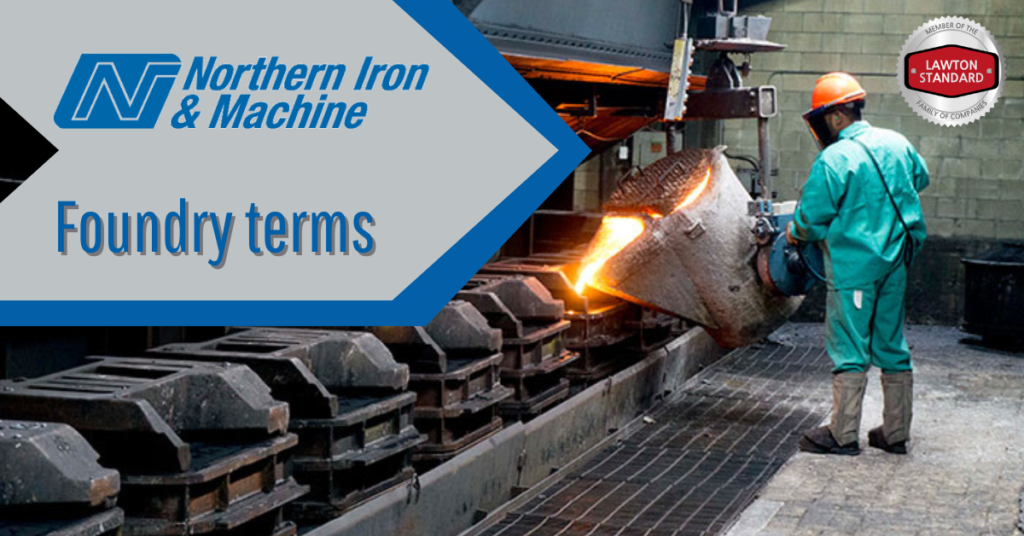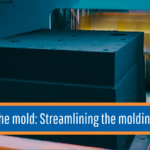Hello and welcome to northernim.com. We thought we’d start off our blog by addressing some common foundry terms. See something we should add to our list? Be sure to contact us with your ideas for our blog.

| Alloy | A metal made by combining two or more metallic elements. The addition of certain chemical elements impart properties into the base metal such as greater tensile strength. |
| Annealing | A process involving heating and slow cooling in a controlled manner in order to alter mechanical or physical properties, particularly hardness softening and stress relief. |
| Blasting | Cleaning a metal object by striking it with high-velocity media, some common media used in the blast process are sand or hard metal shot. |
| Brinell Hardness | A test used to determine the hardness of metals. The test is conducted by applying a known load to a steel ball of known diameter to the surface of the metal that’s being tested. The diameter of the resulting impression that’s made on the test piece is measured. This measurement is cross-referenced to obtain the Brinell hardness value. |
| Burned on sand | A defect caused by metal penetration into mold or core sand. This results in a mixture of sand and metal on the surface of the casting. |
| Cast iron | A series of ferrous alloys that contain over 1.74% carbon. |
| Chaplet | Metal support or spacer is used in molds to help hold cores in the proper position. |
| Chemical analysis | The measurement and reporting of the different elements and also their concentration by percentage, that are found within a material sample. |
| Chill | A metal insert that’s placed in a sand mold, it’s used to produce local chilling and equalize the rate of solidification in the casting. |
| Cope | The top half of a horizontally parted mold. |
| Core | A molded sand insert that is used to form the interior of a casting and occasionally external features |
| Core box | Box made of wood metal or plastic, the cavity of which forms the external shape of the core |
| Core wash | A liquid solution that’s applied to the cores and then dried. The refractory material in the solution is used to prevent metal penetration into the core sand. |
| Coreprint | A projection on a pattern that leaves an impression in the mold for supporting the core. |
| Crush | The deformation of a mold through the displacement of sand at mold joints |
| Cure | To harden. |
| Draft | The taper on the vertical sides of a pattern or corebox that permits the core or sand mold to be removed without distorting or tearing the sand. |
| Drag | The lower or bottom section of a mold, pattern, or flask. In many molding systems, the cope is rotated until it is downward facing and the "drag mold" is dragged underneath it for closing the two halves of the mold. |
| Ductile Iron | Iron in which the carbon is in the form of spherical nodules. This form of iron has greater ductility and toughness and is less likely to promulgate cracks than other cast irons. Ductile iron has good machinability, excellent impact properties, and a high modulus of elasticity. |
| Feeder | Oftentimes referred to as a riser, it is part of the gating system that supplies the reservoir of molten metal that’s necessary to compensate for the losses due to shrinkage as the metal solidifies. |
| Finish allowance | The amount of stock left on the surface of a casting for machining, typically between 3 and 4 mm. |
| Flask | A metal box that’s used to hold the mold sand while the sand is being pressed against the pattern, usually consists of a top and bottom, "cope and drag". |
| Gas porosity | Small voids in a casting that are formed by gas that was trapped when the molten metal was poured into the mold. The initial source of the gas varies. When encountered this defect will usually appear as a smooth spherical void. |
| Gate | The portion of a gating system where the molten metal enters the mold cavity. |
| Gating system | The complete assembly of sprues, runners, and gates in the mold, all of which supply the mold with molten metal |
| Gray iron | Cast iron whose graphite is contained in flakes spread throughout its matrix. Gray iron has excellent castability and good machinability. |
| Green sand | Moist clay-bonded sand that is used for molding. |
| Guide pin | An alignment pin that projects from a flask and is contained by a bushing on the opposite flask. This ensures that the cope and drag molds are properly aligned. |
| Heat | A single furnace charge of metal. |
| Heat treatment | A controlled process of heating and cooling operations that are applied to a casting that’s in a solid state. This process is used to alter the casting in a way that produces the desired mechanical properties. Various heat-treating processes are used to attain different objectives. Annealing is generally used for softening and stress relieving while most other processes are used to harden the casting either locally or all the way through. |
| Inclusions | Slag particles, refractory materials, sand, or deoxidation products trapped in the casting during the solidification process. |
| Inoculant | Materials that are added to the molten metal to modify the structure, and thereby alter the physical and mechanical properties. |
| Ladle | Metal vessel lined with a refractory material that is used to transport or pour molten metal. |
| Mechanical properties | Physical properties which describe the behavior of a metal when it’s subjected to types of mechanical usage. Some examples of mechanical properties are tensile strength, elongation, and hardness. |
| Mold | The complete sand container formed by the union of the cope and drag halves. This "sand box" contains the internal cavity which will become the casting once poured. Also inside the mold are the various risers, runners, chills, filters, cores, and ingate. |
| Mold cavity | The impression in a mold produced by the removal of the pattern. This cavity is filled with molten metal to form the casting. |
| Mold wash | The solution that is used to coat the cavity walls, helps prevent metal penetration into the mold sand. |
| Mulling | The mixing of sand, water, and binding agents in preparation for use in molding or core making |
| Parting Line | The line showing the separation of the two halves of the mold. |
| Pattern | The wood, metal, or plastic shape used to form the cavity in the sand. A pattern may consist of one or more impressions and is normally mounted to a board or plate along with a runner system. |
| Physical properties | The distinguishing characteristics or qualities used to describe a metal. For example: Tensile Strength, Yield Strength, and Elongation. |
| Pig iron | Blocks of iron with known chemical makeup used for the production of ferrous castings. |
| Pour cup | The pattern piece where the molten iron enters the mold. |
| Returns | Metal in the form of gates, sprues, risers, or defective castings which are put back into the furnace for melting. |
| Riser | A reservoir of molten metal used to supply a contracting, cooling casting with additional material, and risers are used to prevent internal or external voids caused by shrinkage. Also referred to as a feeder. |
| Runner | Part of the gating system which carries molten metal from the sprue to the gates. |
| Sand inclusion | Cavities or surface imperfections on a casting caused by sand washing into the mold cavity. |
| Seacoal | Finely ground coal which is mixed with mold sand. |
| Shakeout | The process of separating the solidified casting from the mold material. |
| Shell cores | Cores that have a shell-like structure, made from a mixture of sand and a heat-activated resin that serves as a binder. The boxes that produce these cores are heated. |
| Shrinkage | Contraction of metal in the mold during the solidification (cooling). This term also applies to a type of casting defect. The defect is a void or voids of various geometries that are formed by the insufficient flow of feed metal into the casting during solidification. |
| Slag | Nonmetallic impurities that float to the top of the molten iron during melting and pouring. |
| Sprue | The channel through which the molten metal enters the gating system for distribution to the risers and gates. Also referred to as downsprue. |
| Test bar | Bar poured for determining the mechanical properties of the heat lot. These properties are assessed by way of destructive testing. |
| Vent | An opening or passage in a mold or core that allow gases to escape when the mold is poured. |






